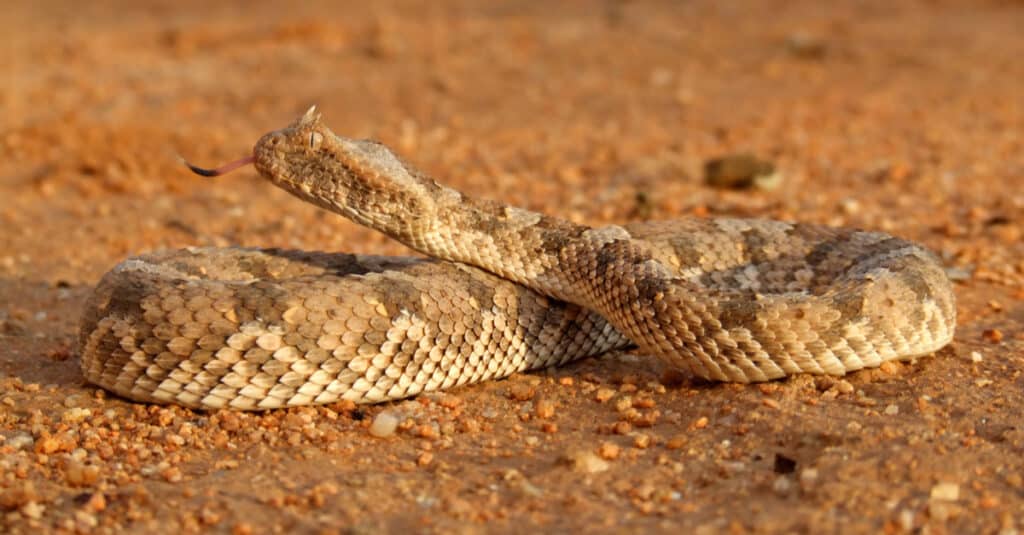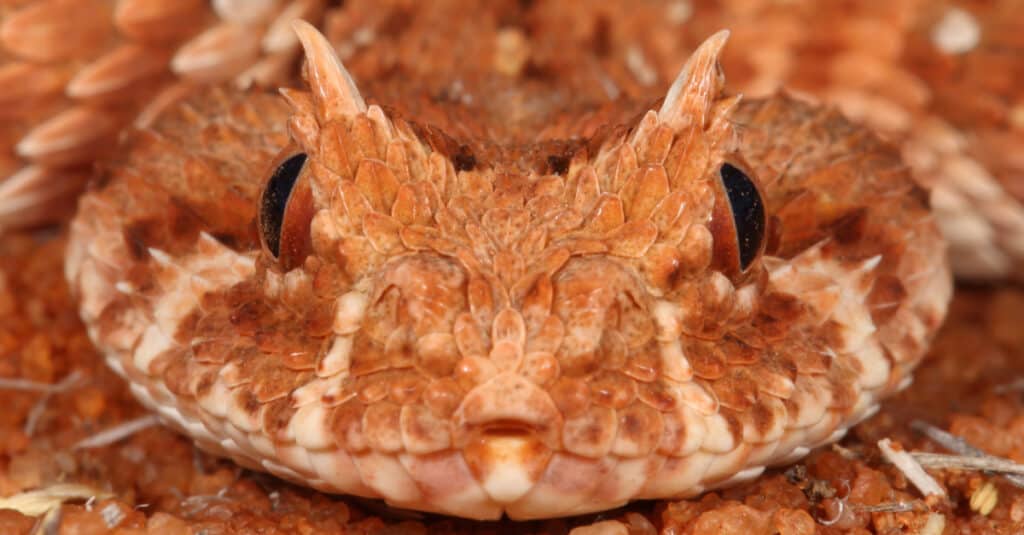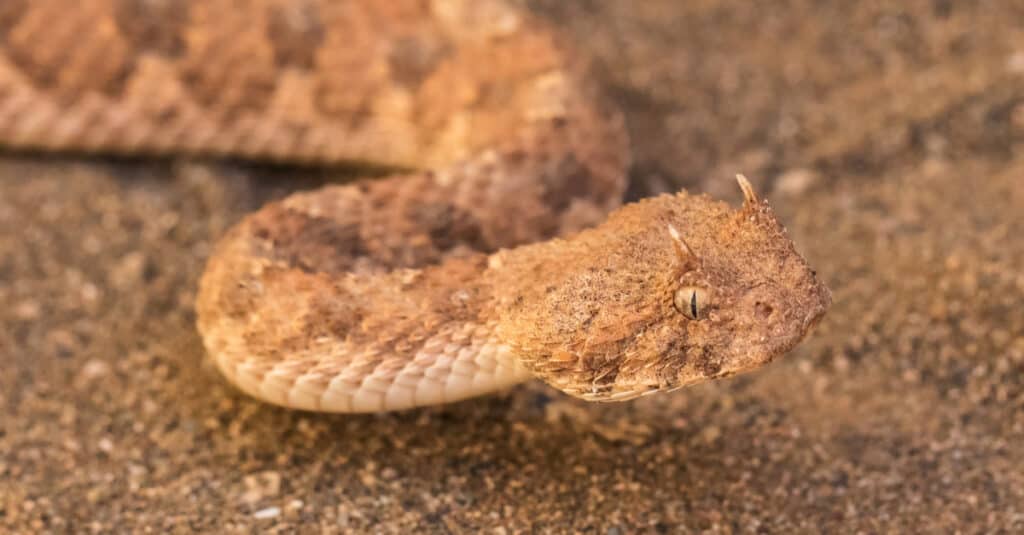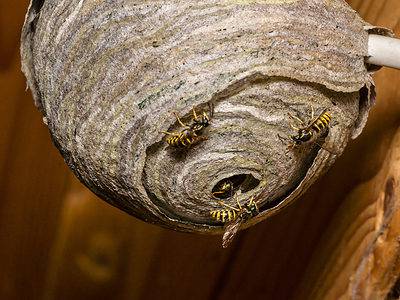Horned Adder
Bitis caudalis
Males tend to be more brightly colored than females, and females are significantly bigger than males.
Advertisement
Horned Adder Facts
- Prey
- Lizards such as geckos, small mammals and birds.
- Group Behavior
- Solitary
- Fun Fact
- Males tend to be more brightly colored than females, and females are significantly bigger than males.
- Biggest Threat
- Agricultural and commercial development, overgrazing, roadways.
- Most Distinctive Feature
- Single scale above the eye that creates a horn.
- Other Name(s)
- Horned viper, horned puff adder, Horingadder, Horingsman (Afrikaans)
- Temperament
- Relatively mellow.
- Litter Size
- 4-19
- Habitat
- Wide range of habitats, but prefers more arid conditions where there's loose sand to bury themselves in.
- Diet for this Fish
- Carnivore
- Lifestyle
- Nocturnal
- Common Name
- Horned adder, Horingadder, Horingsman (Afrikaans), horned viper.
- Number Of Species
- 1
Horned Adder Physical Characteristics
- Color
- Brown
- Grey
- Yellow
- Fawn
- Red
- Skin Type
- Scales
- Length
- 12-15 inches, but can reach 20 inches long in the wild.
- Venomous
- Yes
- Aggression
- Medium
View all of the Horned Adder images!
The horned adder is a snake that buries itself in the sand, leaving only its eyeballs and tail showing!
These diminutive venomous snakes are almost cute with a prominent horn over their eyes. However, they are short and stout, ranking among the smallest venomous snakes in the world. The largest horned adders are females that only reach about 20 inches in the wild.
Horned adders are colorful and widespread across southern Africa, in Botswana, Angola, Zimbabwe, Namibia, and South Africa; they are relatively sedentary and spend most of their time buried in loose sand or soil waiting for their prey.
4 Amazing Facts About Horned Adders
- Females grow much bigger than males, and males are more colorful than females.
- They might use a form of caudal luring to hunt, but biologists need more information to confirm this.
- They have litters of up to 19 live young every 2-3 years.
- Horned adders are cranky, and those who keep them say they’re challenging to handle.
Where to find Horned Adders
These snakes are widespread across southwest Africa and prefer areas that have loose sand they can bury themselves in, leaving only their eyes, horns, and tails visible. Horned adders live in various habitats, and their prey varies depending partly upon that and the snake’s sex. They often seek shade under rocks and bushes during the day’s heat and only venture out in the early morning and evening hours when the heat fades.
Horned adders are ambush predators that wait for their meals to come to them; they may also lure some of their prey by wiggling their tails; horned adders may also actively hunt, but there isn’t enough information to say for sure.
Horned Adder Scientific Name
The horned adder is also called the horned viper, which can confuse some because there’s another snake also called the horned viper. Happily, both species live in different areas of Africa. Their scientific name is Bitis caudalis, and this species is in the Viperinae subfamily of Viperidae.
The Bitis genus includes the puff adder, rhinoceros viper, and over a dozen more. Most are dwarf adders like the Namaqua dwarf adder, which may be the smalled viperid topping out at about 11 inches, but a few are larger; the gaboon viper grows up to 7 feet long.
Other snakes in the Viperinae subfamily include bush vipers, horned vipers, and false-horned vipers; like all vipers, they are venomous. However, some are more dangerous than others, and the horned adder’s venom is on the weaker end of the spectrum and doesn’t need antivenom to treat a bite.
Horned Adder: Population and Conservation Status
According to the International Union for the Conservation of Nature (IUCN), Horned adders have a stable population and are on the IUCN Redlist as Least Concern. Their biggest threats are overgrazing, commercial and agricultural development, roadways, and illegal collection for the pet trade; however, they have a stable population in areas with suitable habitats.
Even though the females don’t breed every year, they have large litters of up to 19 babies. So they seem to have taken an evolutionary path that dictates more young at a time but less frequently. Like many reptiles, the young are miniature replicas of their parents, and both sexes eat more cold-blooded prey when they’re young.
Identifying Horned Adders: Appearance and Description
This snake is a small, thick-bodied viper that only measures 20 inches long at its longest; most are between 12 and 15 inches long. Horned adders mate in the fall and give birth to 4-19 live young in the summer, although the females tend to mate only every other year.
Their scales are keeled, giving them a rough, sandpaper-like texture. There is a single horn above each eye, and they have elliptical pupils. Identifying them is relatively easy; their horns are distinctive. However, sometimes identifying one is a little more complicated because there are a few without horns. Additionally, in areas of Namibia, there appear to be individuals that are hybrids of a horned viper and a Peringuey’s viper.
These snakes are sexually dimorphic and rank in the top 15% of snake species for sexual dimorphism. There are several differences between males and females that help to distinguish the two.
- Males are smaller than females; the largest wild-caught horned adder reported was a 20.9 inch-long female in central Namibia.
- The females also have larger heads and shorter tails; their bodies are also thicker relative to males.
- Males are vividly colored, while the females’ colors are more muted.
- Males also tend to eat more cold-blooded prey than females.
This species has a wide color variation that seems connected to the sand color where it lives; it can vary from gray to brown, or yellow to reddish-orange, and blotches along its back that can be elliptical, rhomboid, or square.

Horned adders’ color varies according to where they live.
©/Shutterstock.com
Pictures and Videos of Horned Adders

Horned adders have a single horn over each eye.
©/Shutterstock.com

Horned adders blend perfectly with their surroundings
©/Shutterstock.com
Venom: How Dangerous Are Horned Adders?
Like other vipers, they have hinged fangs that are hollow and attached to venom glands. They’re considered dangerous, but not overly so. According to the African Snakebite Institute, Horned adders’ venom is mildly cytotoxic and causes swelling, pain, bruising, and occasionally tissue death (necrosis). Antivenom isn’t effective against it, but victims don’t usually need it due to the mild nature of the venom.
Horned Adder Behavior and Humans
It likes to bury itself in the sand at the edges of rocky outcroppings or bushes while waiting for prey to stumble upon it. It may use its tail to lure prey within its reach because this snake isn’t terribly active. Horned adders puff themselves up, hiss loudly, and will repeatedly strike at its perceived threat.
The horned adder is the most common dwarf adder species in southern Africa. They are pretty quick to bite, so the best course of action is to move away slowly when they are agitated. The edges of bushes and outcroppings where it likes to hide are where most altercations with humans are likely to occur. Given their cranky disposition, however, bites seem to be relatively uncommon.
Similar Animals
View all 104 animals that start with HHorned Adder FAQs (Frequently Asked Questions)
Are horned adders venomous?
Yes, but there isn’t enough information to determine how toxic their venom is. Some studies suggest that it’s weak, but others suggest the opposite.
How do horned adders hunt?
They’re ambush predators, which means they wait for their food to come to them. Horned adders bury themselves in the sand, leaving only their eyeballs and tails visible.
Are horned adders aggressive?
No, they’re pretty timid and prefer to go unnoticed, but they defend themselves loudly.
Where do horned adders live?
They prefer arid, sparsely vegetated desert, but live in a wide range of habitats in southern-southwestern Africa.
What do horned adders eat?
Smaller horned adders eat lizards, especially geckos, but the larger ones (these are typically female) prefer small rodents and birds.
Thank you for reading! Have some feedback for us? Contact the AZ Animals editorial team.
Sources
- RepFocus, Available here: http://www.repfocus.dk/Bitis.html
- Reptile Database, Available here: https://reptile-database.reptarium.cz/species?genus=Bitis&species=caudalis
- African Snakebite Institute, Available here: https://www.africansnakebiteinstitute.com/snake/horned-adder/
- Shine, R., Branch, W. R., Harlow, P. S., & Webb, J. K. (1998). Reproductive Biology and Food Habits of Horned Adders, Bitis caudalis (Viperidae), from Southern Africa. Copeia, 1998(2), 391–401. https://doi.org/10.2307/1447433, Available here: https://www.jstor.org/stable/1447433

















